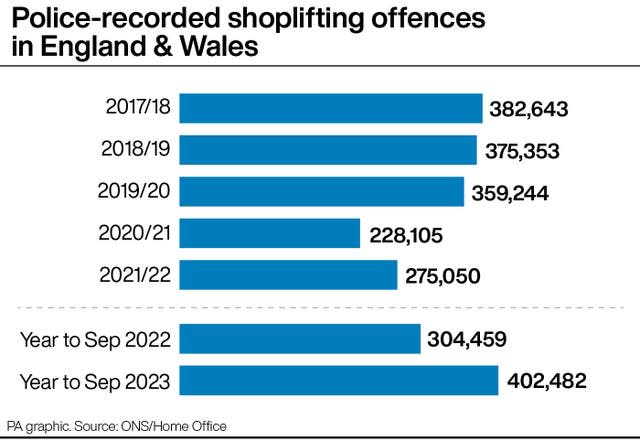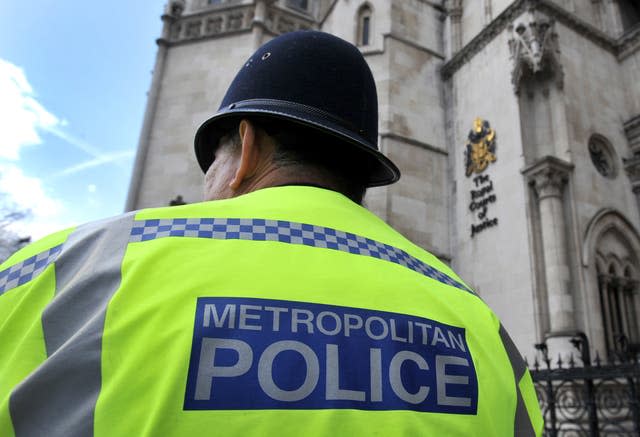Police-recorded shoplifting offences in England and Wales jump 32%
Shoplifting offences recorded by police in England and Wales have risen to the highest level in 20 years, surpassing figures seen before the coronavirus pandemic for the first time.
Some 402,482 offences were recorded in the year to September 2023, up nearly a third (32%) on 304,459 in the previous 12 months, data published by the Office for National Statistics (ONS) on Thursday shows.
It is the first time since current records began in 2002/03 that the number recorded by police has risen higher than 400,000 and is above pre-pandemic levels.
The previous peak of 382,643 was recorded in the year to March 2018.
It comes after major retailers raised concerns about the rising cost of theft.

The figures prompted criticism from political opponents, with Labour claiming the figures demonstrated how “badly the Tories are failing on law and order” and the Liberal Democrats accusing the Government of “sitting on its hands while shopkeepers are left to face a growing shoplifting epidemic”.
The Prime Minister’s official spokesman said: “We’d always want to do more to combat shoplifting” and work was being carried out to see “how we can go further to tackle this issue.”
But Home Secretary James Cleverly insisted “communities are safer” and the Government’s plan to protect the British public is working.
The police recorded 6,233 offences involving firearms in the year ending Sept 2023, a 3% increase compared with the year ending Sept 2022 (6,024 offences).
Excludes Devon and Cornwall. pic.twitter.com/pyyoFo1L8w
— Office for National Statistics (ONS) (@ONS) January 25, 2024
Downing Street also said the Government must do more to tackle knife crime and build on action already taken after the figures showed police-recorded offences involving sharp instruments rose year-on-year.
Some 48,716 such offences were recorded in the 12 months to September 2023, up 5% from 46,367 in the previous 12 months. But the figures have not yet returned to levels seen before the Covid-19 pandemic and are still 5% lower than the 51,228 in the year to March 2020.
The overall number of crimes recorded by police in England and Wales in the year to September 2023 stood at 6.7 million, up slightly (1%) from 6.6 million in the previous year and higher than 6.1 million in the pre-pandemic year of 2019/20.
Catherine Grant, from the ONS, said there was a “mixed picture of crime” but figures recorded by police showed “notable increases in some theft offences”.

The police data for England and Wales also shows:
– Robbery offences increased by 12% to 79,091 compared with the previous year (70,792) but remained 12% lower than before the pandemic. Some 90,187 offences were recorded in the 12 months to March 2020.
– There was an 8% jump in police-recorded theft or unauthorised taking of a motor vehicle offences to 132,489.
– Firearms offences rose by 3%, from 6,024 to 6,233. These figures exclude Devon and Cornwall Police due to problems with a computer system. The biggest rise was for imitation firearms, which went up 24% to 2,659 offences.
– Some 191,186 sexual offences were recorded, down 3% from 198,106 in the previous 12 months, but 17% higher than the 163,326 in the pre-pandemic year of 2019/20.
– The number of homicides fell 9% to 591, compared with 651 recorded in the previous year.
Offences involving knives or sharp instruments increased by 5% (48,716 offences) compared with the year ending Sept 2022 (46,367 offences), but remain 5% lower compared with the year ending March 2020 (51,228 offences).
Excludes Devon and Cornwall and Greater Manchester Police. pic.twitter.com/5Zw3rEahzM
— Office for National Statistics (ONS) (@ONS) January 25, 2024
Separate Home Office figures show the proportion of investigations into crimes recorded by police in the year to September 2023 which were closed with no suspect identified rose from 36.8% to 40.3%.
Meanwhile, the proportion of suspects being taken to court stood at 5.9%. In rape cases this was 2.4%. These are both slight increases on the previous period (5.5% and 1.6% respectively) but still among the lowest levels recorded.
The ONS release includes some data that reflects changes in how crimes are logged by police forces. Reforms of so-called Home Office counting rules, which concerns the logging of incidents, were rolled out across England and Wales from June 2023.
Some have raised concerns about the effect the rule change could have on crime data but the ONS said it is “too soon” to tell and will “take some time” before any impact is seen.
Improvement in the recording of offences by police, together with more victims reporting crime, changes in the data to include new offences, plus “genuine increases” in some kinds of crime, have “each made substantial contributions to rises in recorded crime over recent years,” the ONS said.
The figures are likely to reflect improvements in police recording practices and increased reporting by victims, which means they “do not provide a reliable measure of trends in these types of crime”, the ONS added – though they “do provide a good measure of the crime-related demand on the police”.
Compared with YE Sept 2022:
▪️ theft offences were up by 9%, with a 32% rise in shoplifting
▪️ vehicle offences rose by 2%, including an 8% increase in theft or unauthorised taking of a motor vehicle (a 17% increase compared with the YE March 2020)
➡️ https://t.co/WB1I6wQGDk pic.twitter.com/dnqiz5Vw46
— Office for National Statistics (ONS) (@ONS) January 25, 2024
Figures from the separate ONS Crime Survey for England and Wales suggest people aged 16 and over experienced 8.5 million offences in the year ending September 2023, down 7% from 9.1 million on the previous year.
The report measures experiences of crime in the 12 months before interview, meaning the latest survey – which was conducted between October 2022 and September 2023 – reflects crimes that could have occurred as far back as October 2021.
Experiences of crimes, as measured by the ONS survey, have been on a broad downwards trend since the mid-1990s.
The Home Office uses the results of the crime survey to point to a drop in crime and argue the success of Government policies.
But the ONS questionnaire does not cover all types of crime, such as sexual assaults including rape, domestic abuse and stalking, prompting warnings that the data hides the extent of violence against women and is therefore unable to provide a clear picture of overall crime.
Collecting data on victims’ experiences of such crimes is challenging because they may not wish to speak openly if their abuser or relatives unaware of their ordeal are present, the ONS said. Such incidents are instead analysed in separate research.
